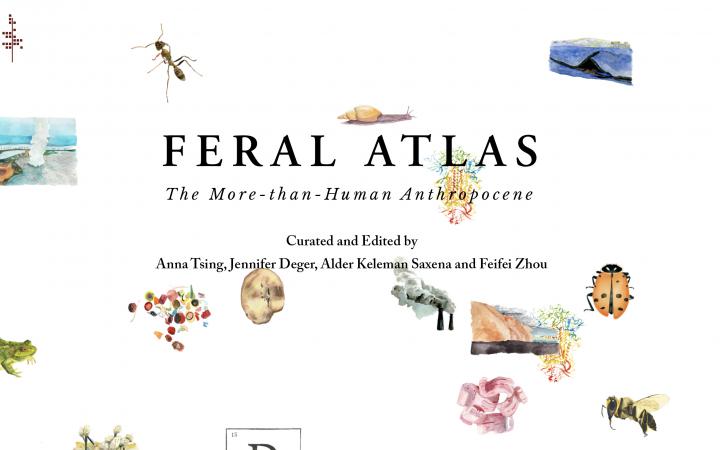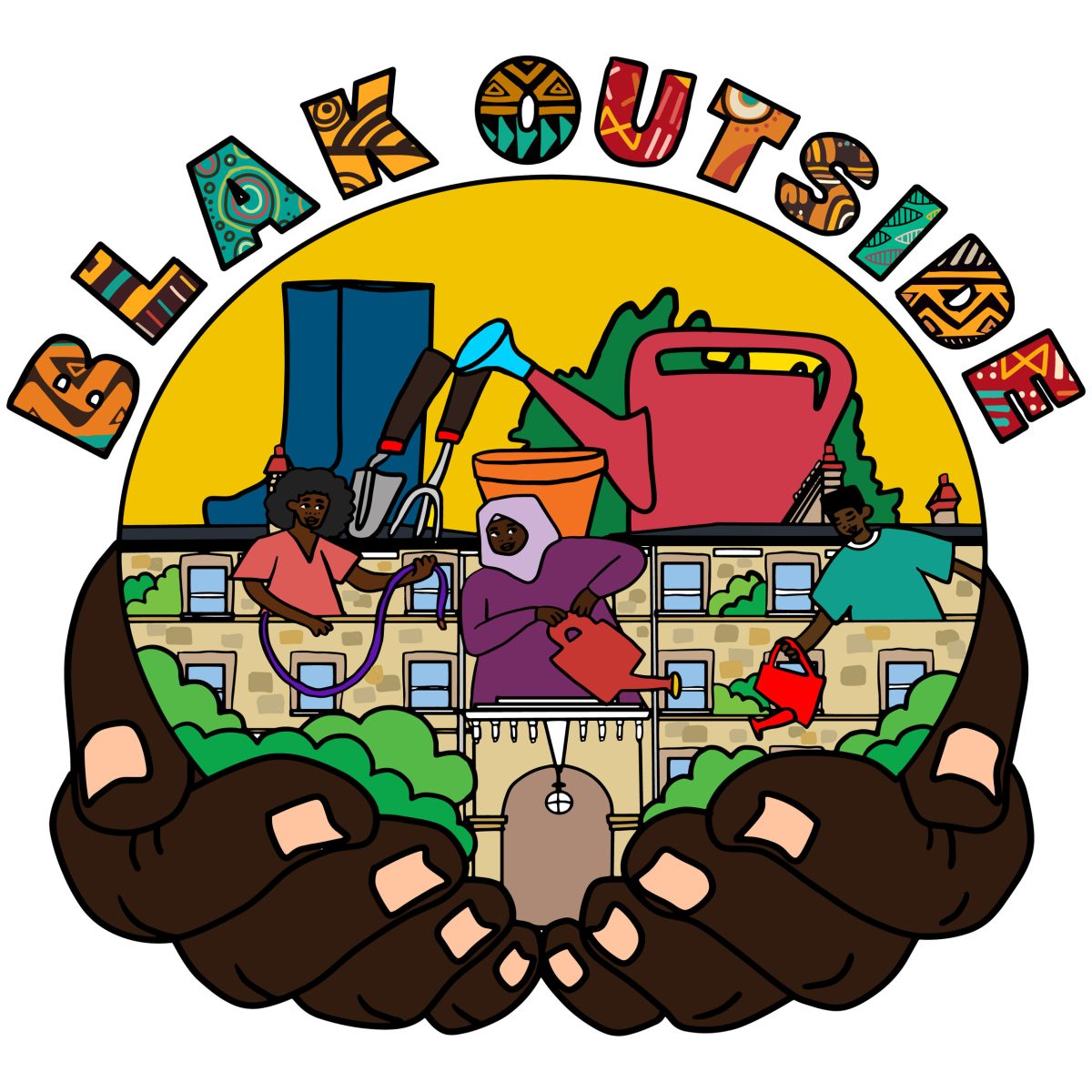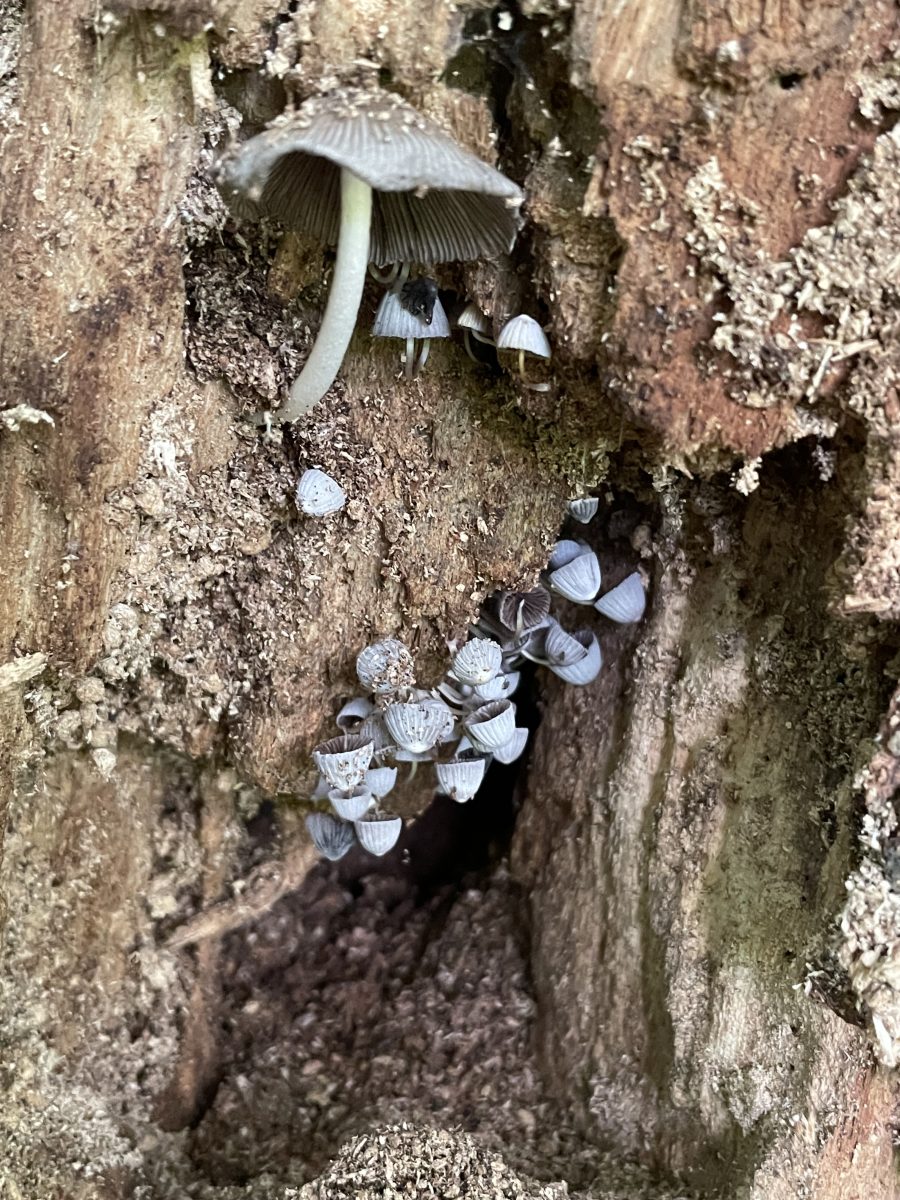Artist and researcher Jol Thoms offers his reflections on No Happy Ending: Storytelling at the end of the world, the recent CREAM Documentaries of the Imagination discussion between lead researcher and award-winning filmmaker Joshua Oppenheimer (The Act of Killing, The Look of Silence) and Mushroom at the End of the World (2015) author and anthropologist Anna Tsing. In this conversation, the radical thinkers and makers focussed on a critical question concerning communication in the inevitable planetary condition of climate catastrophe, asking: “How on Earth do we tell stories if indeed there may be no happy ending?”
“To use the world well, to be able to stop wasting it and our time in it, we need to relearn our being in it…What tools have we got to help us make that reach?”
– LeGuin in Tsing et al. (2017, p.15/16)
“I feel embarrassed when I say feminism and people do not think revolution in service of every living thing”
– Lola Olufemi (italics in original, 2021, p.13).
“While story opens us to pain, doubt, and vulnerabilities, it also opens us to healing”, writes Annie Chau in Feminist Activist Storytelling (2020, p.98). In their conversation Joshua Oppenheimer and Anna Tsing (who are referred to as O&T from hereon) are suggesting that we need to stay with the trouble, to accept the pain, the existential angst of the calamitous situations rapidly unfolding around us. It is through this type of sober honesty and clear-headedness that leads to a generative cognitive dissonance that we might refer to as an approach to ‘climate-realism’. If there is to be any ‘healing’ from this position, it might include recovery from a centuries old trance, the old western logic with a fetishistic allure – what they refer to as a type of ‘magical realism’ – one that slyly invents an endless supply of products and resources to be metabolised and excreted without any repercussions. For Mark Fisher (2009) persistence of Capitalist realism “depends on this fantasy structure”, so, “How do we imagine a future without this kind of magical realism?” O&T ask.[i]

To attend to these heavy questions Storytelling at the end of the world began with a tour of Tsing and her collaborators’ open-access online compendium of ‘Anthropcenic infrastructural ecologies’, the edited and curated digital humanities volume www.feralatlas.org (2020). As a collective critical storytelling experiment and a radical form of pedagogy, Feral Atlas, with all of its text, artworks, poetry, and feral entities, “suggests new ways of thinking about thinking”, and renewed ideas about what constitutes a map.
What constitutes a map is critical to consider for a number of reasons, not the least because they’re a significant way that we represent and understand space and relations, but here I’d like to highlight cartographies use in law and governance: the description of property and land-ownership, in Environmental and Biodiversity Protection, and in the interpellation of ‘Natural Assets’ newly essential to Capital and Finance (what Marxist Ecologist John Bellamy Foster has termed, ‘The Great Expropriation’).[ii]
In ‘The Great Derangement’, Amitav Ghosh challenges literature’s failure to address or attend to the climate emergency in any relevant fashion. Of course, here, with Storytelling, we’re speaking beyond the discipline of literature, recognising any epistemic, ontological, or cosmological reality as predicated on the telling of stories. Oppenheimer asked, “how do we tell stories about what’s at stake in telling stories?” It’s a line of questioning getting deeper into the motivations or bias humans build into the stories they tell, and the stories they tell about themselves (and nonhuman others).
Without attempting to be deflationary Tsing said that Feral Atlas might be a multi-scalar approach to thinking and visualizing ‘the claustrophobia of being in a world made by our own garbage’. As capitalist economies and their militaries’ garbage pile amasses from the bottom of the Ocean, through the soil and groundwater, up into
the atmosphere, and mineralizing in all planetary bodies, we begin to understand the scope of their concern, and the idea that there can be no happy ending. But might that be a nostalgic approach from a puritanical perspective? For whom can there be no happy ending? Eve Tuck (2009) informs us that “damage-centered research” can
magnify the very harms it seeks to mitigate. So which of the human communities or generations deserves that shame?

The World has become a terrifying place
O&T began their conversation with a reflection on Mushroom at the End of the World, how it exposed that “the world has become a terrifying place”, within which “it has become difficult to know how to make a life”. Here it could be interesting to reconsider the very notion of ‘a life’. What does it consist of, in an expanded, embodied sense? Tsing reflects on the holobiont:
“The most exciting thing in biology is the recognition that no species lives by itself… We exist for [multicellular life] as much they exist for us. We’re their patch – but it’s in every level too – we can’t digest without bacteria in our bodies; so many insects can’t reproduce without a specific bacteria; organisms can’t come to maturity without bacteria; the production of oxygen – none of us can (or do) live by ourselves”
To elaborate on this realisation it might be helpful to think with artist Himali Singh Soin and artist, educator and scientist Phoebe Tickell (aka Solarpunk Girl). What happens when stories are no longer ‘ours’, meaning they’re no longer so obsessively anthropocentric? In a world where ‘we’ humans are beginning to understand ourselves in deep time processes, fuzzy-boundaried porous beings that emerge, fruiting like mushrooms from a network of mineral, bacteria, virus, liquids – what collaborative stories can be told from this poly-perspective: the expanded notion of holobiontt? [iii]
Drawing on Jane Bennet, Ian Bogost, Jan Zalasiewicz, and Tristan Tzara, Himali Singh Soin’s SIlicontology (2017) lecture-performance champions this renewed mode of knowing our ‘selves’ as multiple – what Fred Moten’s organizing aphorism “consent to be more than one” might also attest.
“Silicontology is an assemblage of invisibilities: a tangle of intimate distances between human and nonhuman entities…. May(be) a speculative ecosystem, a forest of curious, dystopian, dangerous, deluded, shimmering whispers… coded with the ghosts and absences of the deleted and drowning”.

Artist-scientist Tickell helps us embody this particular flavour of expanded being in her meditation at AmbikaP3 and the Serpentine’s A Circle in the Mind of a Fish presentation in December 2018.[iv] In this deep time meditation we become aware of the saliva of a dinosaur passing through our own fleshy hydrological system, and we feel the shells of ancient marine creatures in our calcium structures, our bones and bloods deeply entangled in the creaturely histories of Earths entangled biologies.
This slow fragmenting of a suffocating anthropocentrism at the heart of capitalist realism is necessary and refreshing and can contribute to renewed storytelling in the face of the ecological conditions we’re facing. This decentering of the human from linear space and time represents a conceptual renewal, a transitioning mindbody for planetary subjects and their stories, one that evades and eludes the straight jacket of a deeply flawed and darkly limited Western onto-epistemology. Good examples of climate realism might be Gun Island by Amitav Ghosh (2019), Richard Powers’ The Overstory (2018), Joan Jonas’ Moving Off the Land (2019) performance, or Cauleen Smiths video Songs for Earth and Folk (2013). An all-time favourite of mine is the video by Ted Chiang and Allora and Calzadilla’s: The Great Silence.
In the Storytelling discussion Tsing asks, “So, in a sense are, we ‘human beings’? Are we ‘ourselves’?” And she answers: “No – we don’t know what ‘ourselves’ is – we are also hosts and colonies of blue green algae”. This is a beyond-boundaries (poly-)perspective, a form of continuum-thinking I have been interested in for the last decade. I wonder what this ecological situation that disrupts classical boundaries of what constitutes any ‘thing’ also means for storytelling in the face of Kimberlé Crenshaw’s articulation of intersectionality? Could this gesture towards a form of healing from the exhaustion of hetero-patriarchal hierarchy; of the modern individual; of being only one?

Hope and the end of the world
Oppenheimer and Tsing discuss how they’re interested in a “Hope that’s not an attempt to erase all the terrible things – hope as a term can still be useful to us,” they say, “but only if we don’t allow it to be passive”. The conversation of Oppenheimer and Tsing does generate an active hope, and it is unfortunate that there isn’t enough space here to reflect on all of their great ideas, questions, and provocations. In the context of ‘creating a tragedy from which we can all learn’ they they criticise the type of hope that popular media seduces societies into, which performs activism for us without our need to actually engage and demand. In Capitalist Realism Mark Fisher (2009) stated that this tactic of capitalism leads to a passive condition he calls ‘reflexive impotence’. This “can only be threatened,” he writes, “if [capitalism] is shown to be in some way inconsistent or untenable; if, that is to say, capitalism’s ostensible ‘realism’ turns out to be nothing of the sort”(p.16). Stories without happy endings can still offer hope because they open us to vulnerability and offer a strategy towards defeating the ruin inducing logic of Capital that performs an anodyne ‘activism’ for us.
Green imaginaries of active hope like solarpunk really inspire me, and offer narrative strategies for a broken present-future.[v] It’s important to keep our strategies both critical, climate-realist, and motivating. New stories that create new kinds of taboos on an international scale might be able to do that. And as yet another ‘end of the world’ looms, (here we can think of the ongoing historical condition of colonialism as a form of eschatology, or Walter Benjamin’s insistence that history is not a linear progression but an ongoing cycle of catastrophe’s), riffing off LeGuin: what tools have we got to convince people to make sacrifices? Perhaps a cultural shift towards unhappy endings is a way towards that – because sacrifices need to be made. While solarpunk might attempt to eschew the question of sacrifice, it may need to contend with this aspect of climate realism in the future.
I began this commentary with Olufemi’s particular understanding of feminism because I believe that perhaps one of the most salient responses to their questions may be, “we tell feminist stories”, where feminist means caring, honest: with no bullshit – climate realism ‘in the service of every living thing’ recognizes social justice within the very notion of climate. Climate realism might then be an intersectional frameworkinformed by the likes of bell hooks, Max Liboiron, Gloria Anzaldua, Linda Tuhiwai-Smith, Olufemi, Tsing – and so many others – while also being multi-generational, informed by youth as much as elders.
From their discussion, it seems that O&T are grappling with some of the deepest questions facing planetary subjects in the 3rd decade of the 3rd millennium. By the end their emphasis is on activism: “Activism in its most effective form is changing the story: changing the structure of how we work together; enlarging the group of people with whom we might work together; to form coalitions to find common ground – including to alliances with non-humans as well as humans”.
So what’s got you active?

[i] In Fisher’s Capitalist Realism (2009), he states, “this treatment of environmental catastrophe illustrates the fantasy structure on which capitalist realism depends: a presupposition that resources are infinite, that the earth itself is merely a husk which capital can at a certain point slough off like a used skin, and that any problem can be solved by the market”.
[ii] Since November 2021, so called ‘Natural Assets’ have entered the international market as a new category. Multinational corporations have begun illicitly buying up huge swaths of land and water the world-over, “often expropriated from indigenous populations and subsistence farmers” (2022, np). See Foster’s articles: “Nature as a Mode of Accumulation: Capitalism and the Financialization of the Earth” (2022), and “The Defense of Nature: Resisting the Financializaton of the Earth” (2022) in Monthly Review: An Independent Socialist Magazine.
[iii] Holobiont is a multispecies nesting concept that emphasises how lifeforms are communities and pluralities of living things, from the micro to macro scale, which is often attributed to Lynn Margulis. It refers to the many types of bacteria, viruses, and beings living on and inside one another and is one of complex life’s essential strategies for the production and maintenance of earthly beings’ bodies. A human is a holobiont made of up thousands of bacteria, eukaryotes, viruses. An expansion the holobiont thinks the a/biotic atomic histories that go into the genealogies of beings, from the mineral, gas and liquids, etc. of Earth’s deep time necessary for multicellular life. See the next endnote for an elaboration.
[iv] See: Phoebe Tickell, (2018). Entangled, networked and blurred boundaries.
[v] Solarpunk is a growing, emergent ‘memetic engine for imagining a better world’. There are a lot of resources online, but one place to start might be: Solarpunk: A Narrative Strategy, a Memetic Engine w/ Jay Springett and the ‘Solarpunk Girl’ Interview on the Green Pill.
Bibliography
Ahmed, S. (2019). Living a Feminist Life. Duke University Press.
Chau, A. (2020). “Feminist Activist Storytelling: Transforming Identity and Building Resistance”. Canadian Journal for the Study of Adult Education, 32(2), 91-101.
Fisher, M. (2009). Capitalist Realism: Is there no alternative? Zero Books.
hooks, b. (1994). Teaching to transgress: Education as the practice of freedom. Routledge.
Olufemi, L. (2021). Experiments in Imagining Otherwise. Hajar Press.
Tsing, A. L., Bubandt, N., Gan, E., & Swanson, H. A. (Eds.). (2017). Arts of living on a damaged planet: Ghosts and Monsters of the Anthropocene. U of Minnesota Press.
Tuck, E. (2009). Suspending damage: A letter to communities. Harvard educational
review, 79(3), 409-428.